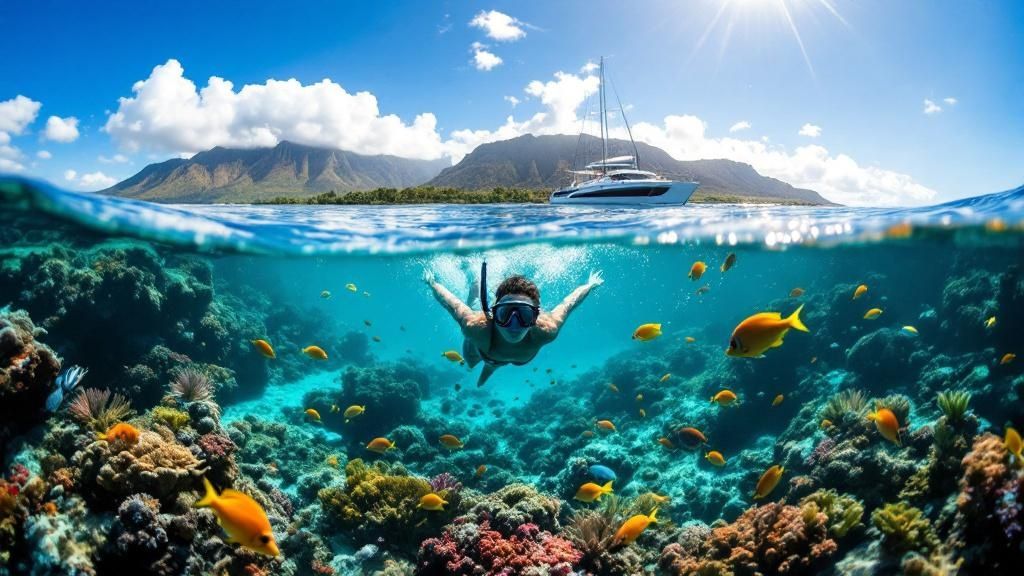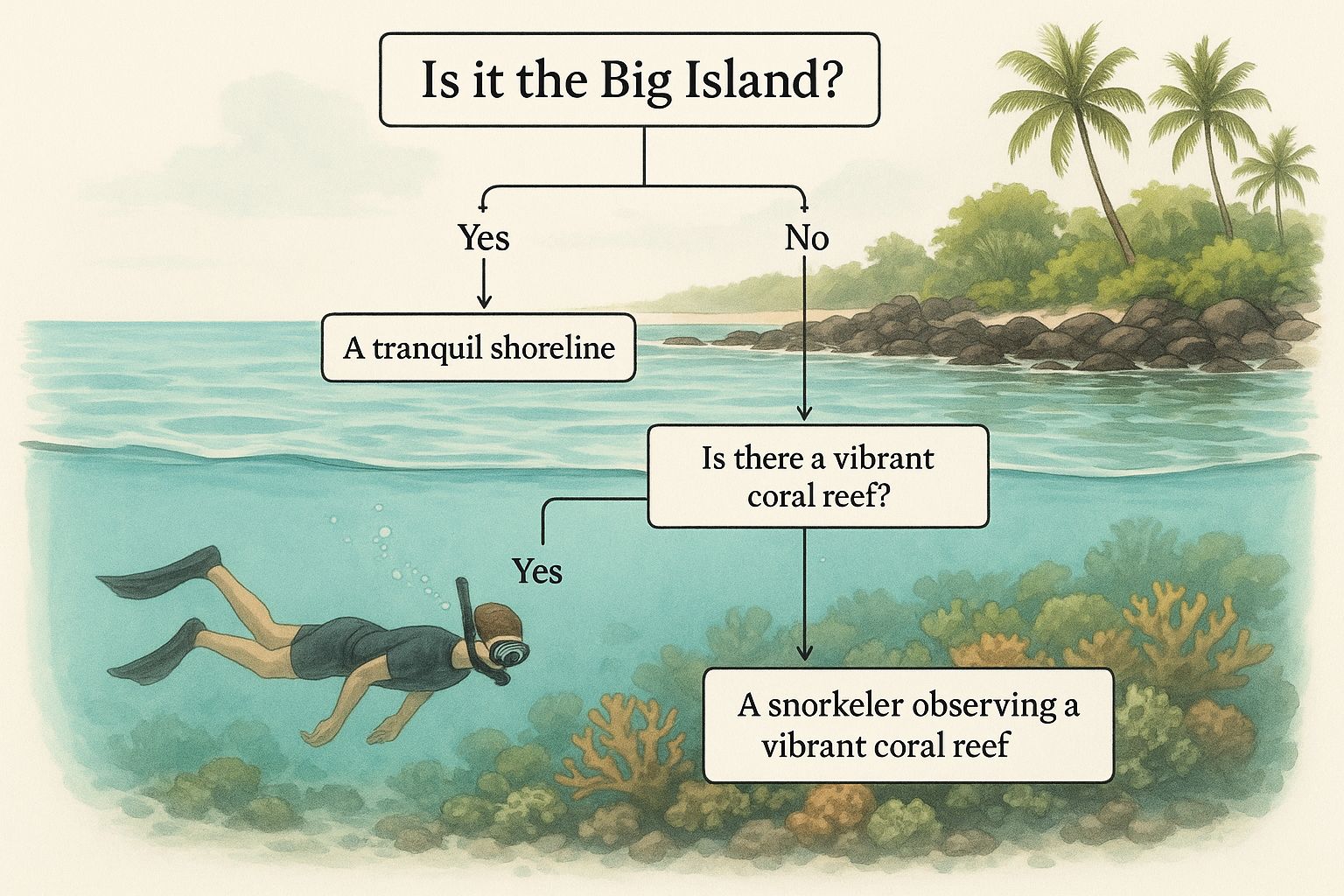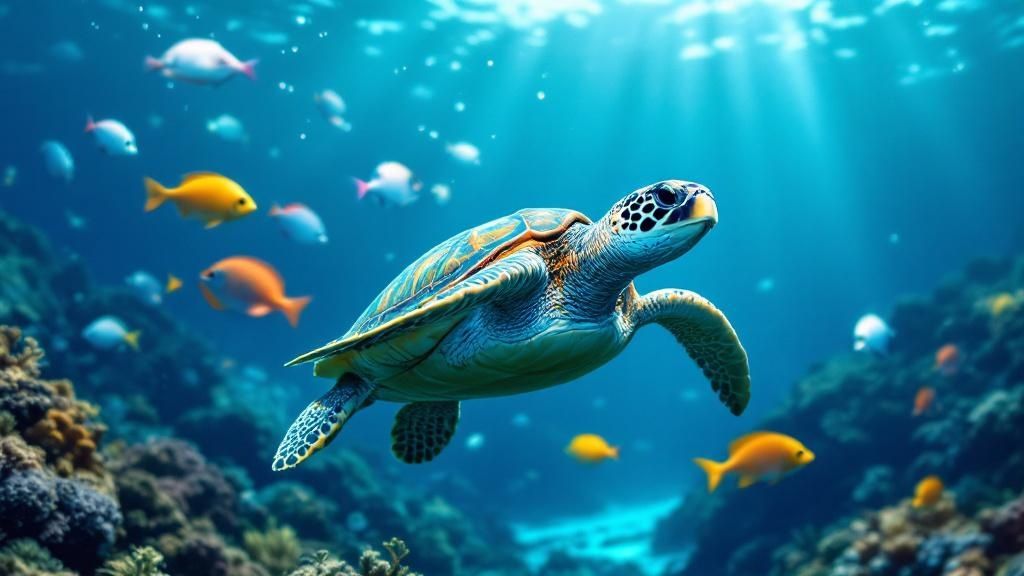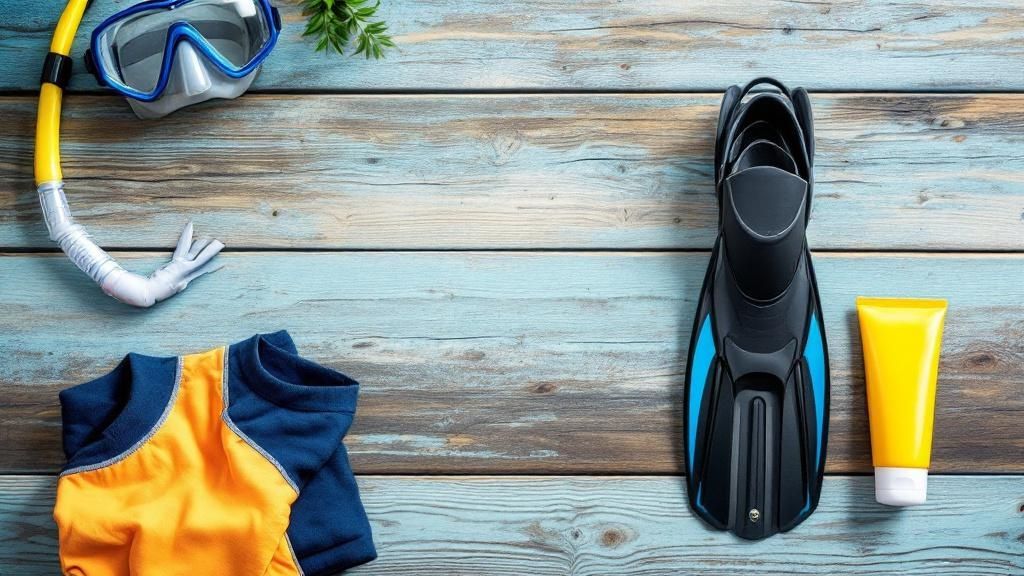Big Island Snorkeling Tours Guide

Picture this: you're floating weightlessly in brilliant turquoise water, watching a rainbow of tropical fish dance through ancient underwater lava caves. That’s not a dream—that's just a regular day of snorkeling on the Big Island of Hawaii, and it’s consistently one of the absolute best things you can do here. This guide will be your go-to for figuring out all the incredible underwater adventures the island has to offer.
Why Big Island Snorkeling is in a League of its Own
The Big Island isn’t just another pretty place with nice water. Its one-of-a-kind geology and serious commitment to conservation have created a snorkeler's paradise. The island was literally born from volcanoes, and that has sculpted a mind-blowing underwater world of lava tubes, dramatic arches, and deep ledges. This rocky terrain is the perfect apartment complex for a wild variety of marine life.
Unlike coastlines with lots of sand that can get stirred up and murky, the lava rock foundation helps keep the water unbelievably clear. This is especially true along the Kona coast, which is naturally calm and sheltered. Plus, several key areas have been designated as Marine Life Conservation Districts—think of them as national parks for the ocean.
These protected zones, like the world-famous Kealakekua Bay, are off-limits to fishing and have strict rules in place. This allows the coral reefs and fish populations to absolutely thrive, free from human pressure. The result is an underwater ecosystem so vibrant and healthy, it feels like swimming inside a giant, pristine aquarium.
This focus on preservation is exactly why so many big island snorkeling tours head straight for these spots. A good tour operator can get you to places bursting with life that are tough, if not impossible, to reach on your own.
Quick Guide to Big Island Snorkeling Tour Types
Navigating the different tour options can feel overwhelming. To help you get started, here's a quick rundown of the main types of snorkeling excursions you'll find on the Big Island. This table breaks down what each one is all about so you can zero in on the perfect fit for your crew.
| Tour Type | Best For | Typical Location | Skill Level |
|---|---|---|---|
| Catamaran Cruise | Families, relaxation, and groups wanting comfort and amenities. | Kealakekua Bay, South Kona Coast | Beginner to Intermediate |
| Zodiac/Raft Tour | Adventure seekers, thrill-lovers, and those wanting a faster ride. | South Kona Coast, Sea Caves | Intermediate |
| Morning Tour | Beating the crowds and enjoying the calmest ocean conditions. | Kealakekua Bay (Captain Cook) | All Levels |
| Afternoon Tour | A more relaxed schedule, often with fewer boats at popular spots. | Kealakekua Bay, Pawai Bay | All Levels |
Each tour style offers a different vibe and experience, from a laid-back day on the water with lunch included to a high-speed adventure that will get your adrenaline pumping. It all comes down to what kind of day you're looking for.
What to Expect on a Tour
Going with a guided tour is about so much more than just a boat ride. It’s a complete package designed for safety, education, and getting you to the absolute best spots. Most quality companies handle everything, providing all the gear you need—masks, fins, snorkels, and flotation devices—so you can just show up and be ready to go.
Here’s what you can expect from a top-notch tour:
- Expert Guidance: The crew aren't just boat drivers; they're usually marine life experts and certified lifeguards. They'll give you the rundown on what you're about to see and how to stay safe in the water.
- Prime Locations: These tours have the permits to access the most pristine and protected reefs, like the famous Captain Cook Monument inside Kealakekua Bay.
- All-Inclusive Amenities: Especially on the larger catamaran trips, you'll often find snacks, drinks, and even a full lunch included. It makes for a completely stress-free day.
- Educational Component: You’ll actually learn something cool! The crew will point out different fish, explain why the coral reef is so important, and teach you how to be a good steward of the ocean.
Choosing Your Ideal Snorkeling Adventure
Picking the right snorkeling tour on the Big Island can feel overwhelming. It’s a bit like standing in front of an amazing buffet—everything looks incredible, but what’s really going to hit the spot for you? Not all boat trips are created equal. Each one offers a totally different vibe, a unique atmosphere, and its own level of adventure.
Let's break it down to help you figure out which one is calling your name. Think of it like this: are you looking for a chill, resort-style pool day, or are you ready to go off-roading to find a hidden waterfall? Your answer will point you straight to the perfect boat.
Large Catamaran Tours: The Floating Lanai
These big, stable catamarans are the most popular option, and for good reason. They're basically a floating lanai (that’s a Hawaiian porch), built from the ground up for pure comfort and relaxation. You’ll usually find shaded seating, real bathrooms, freshwater showers to rinse off, and sometimes even a slide off the back for a splashy entrance.
This setup makes them a fantastic choice for families with little ones, anyone who's a bit nervous about their first time snorkeling, or simply folks who value having all the amenities. The atmosphere is social and easygoing, with the crew often serving up snacks, drinks, and sometimes a full-on BBQ lunch.
- Best For: Families, larger groups, and anyone prioritizing comfort and amenities.
- Atmosphere: Social, relaxed, and super family-friendly.
- Key Perk: Unbeatable stability and creature comforts like restrooms and slides.
Small Raft Tours: The Oceanic Roller Coaster
On the complete other end of the spectrum, you have the small raft or Zodiac tours. These are the ocean's answer to an off-road 4×4 adventure. These rigid-hulled inflatable boats are lightning-fast, sit low to the water, and can turn on a dime. That agility is their superpower, letting them duck into sea caves, explore ancient lava tubes, and visit secluded coves that the big boats can only dream of.
The ride itself is a huge part of the fun—expect a bumpy, thrilling journey that’s guaranteed to get the adrenaline going. These trips are really for the adventurous souls who don't mind trading a few comforts for a more intimate and exhilarating day on the water. Because the boats are small, the groups are too, which often means you get a much more personal tour.

So, what's it going to be? A laid-back day with all the perks, or a heart-pumping, up-close expedition? Your gut feeling is probably already telling you which tour has your name on it.
Manta Ray Night Snorkel: A True Bucket-List Experience
This isn't your average snorkeling trip; it's one of the most incredible wildlife encounters you can have, anywhere in the world. The Manta Ray night snorkel is less about swimming around and more about witnessing pure magic. After sunset, the boat heads to a special Manta spot and shines powerful lights into the dark water. The light attracts swarms of plankton, and the plankton brings in the giants.
You'll hang onto a specially designed floatation board equipped with its own lights. From there, you just watch as these gentle giants, with wingspans reaching up to 16 feet, glide, swoop, and barrel-roll in a silent ballet just inches beneath you. It’s a surreal, completely safe, and profoundly moving experience that people travel across the globe for.
It's perfect for almost anyone, since you're mostly floating and observing rather than kicking around. Honestly, it's a must-do if you're on the Big Island.
Dolphin Watching and Snorkel Combos
A lot of tour operators offer a fantastic two-for-one: a trip that combines world-class snorkeling with the chance to see Hawaii’s famous spinner dolphins. These trips are carefully regulated to make sure the dolphins are respected, so you'll be watching from a safe distance. No reputable company will ever promise you a "swim with dolphins" experience, but seeing them leap and spin in their natural habitat is a thrill all on its own.
Typically, after spending some time watching the dolphins play, the captain will motor over to a premier snorkel spot like Kealakekua Bay to let you get in the water. It’s the perfect way to pack both amazing wildlife viewing and fantastic underwater exploring into one incredible day.
Unlocking the Best Snorkel Destinations
When you book a Big Island snorkeling tour, you're not just paying for a boat ride. You're getting a golden ticket to some of the most stunning underwater theaters on the planet. These premier spots are often protected, hard to get to, or just plain better with the local know-how of an experienced crew. Each one has its own personality, history, and a unique cast of marine characters.
Let's go beyond just names on a map and dive into what makes these legendary locations so special. It helps to understand the story behind a place before you jump in.

Kealakekua Bay: The Crown Jewel
Kealakekua Bay is so much more than a snorkel spot; it's a living museum and a protected marine sanctuary. Famous for its connection to Captain James Cook, this bay is a bucket-list destination for nearly every top-tier snorkeling tour on the island. Because it's a Marine Life Conservation District, the coral gardens here are incredibly vibrant and packed with fish.
The bay is also naturally shielded from the open ocean swells, creating almost swimming-pool-like conditions. Visibility often pushes past 100 feet! That kind of clarity lets you see the entire underwater landscape unfold below you, from the shallow reefs near the monument to the dramatic drop-offs patrolled by bigger fish.
Why a Tour is Essential: Getting to the best snorkeling near the Captain Cook monument by land involves a pretty grueling hike. A boat tour, on the other hand, glides you right up to the action, saving your energy for what really matters: exploring that spectacular underwater world.
Hōnaunau Bay: The Sacred Haven
Known by locals as 'Two Step,' Hōnaunau Bay sits right next to the Puʻuhonua o Hōnaunau National Historical Park, an ancient Hawaiian place of refuge. That spiritual significance seems to flow right into the water, because the bay is an incredibly calm haven for a huge population of Hawaiian green sea turtles (honu).
The nickname "Two Step" comes from the natural lava rock ledges that form perfect steps for getting into the water. It’s a very popular shore-snorkeling spot, but the sheer density of marine life makes it a fantastic stop on many Big Island snorkeling tours. While you can snorkel here for free, it's absolutely critical to respect the wildlife. Spinner dolphins often rest here, but federal law requires you to stay at least 50 yards away to protect them.
Having a guide on a tour is a huge plus. They can point out cool creatures you might miss and make sure everyone is interacting with the environment respectfully.
Pawai Bay: The Secluded Gem
If Kealakekua is the famous landmark and Two Step is the turtle sanctuary, then Pawai Bay is the exclusive, hidden gem. Tucked away on the North Kona coast, this pristine bay is only accessible by boat. That means it sees far fewer people and remains in a nearly perfect, natural state.
This exclusivity is exactly why it’s a prized destination for many of the more specialized snorkeling tours. The underwater scenery is a dramatic mix of coral-covered lava arches, canyons, and swim-throughs. It's a true playground for both fish and snorkelers.
What Makes Pawai Bay Special:
- Secluded Access: Because it’s boat-access only, you completely escape the crowds.
- Complex Topography: The underwater lava formations feel like a submerged city, with endless nooks and crannies to explore.
- Diverse Marine Life: The healthy reef supports a massive variety of fish, eels, and even the occasional graceful manta ray.
These spots are just a handful of the incredible places a guided trip can take you. For a deeper dive on these and other amazing locations, check out our guide on the top 15 best snorkeling spots on the Big Island. Ultimately, choosing a tour unlocks these premier destinations and turns a simple swim into an expedition you won't forget.
How To Pick The Right Snorkeling Tour Company

Alright, you've got the basics down on what snorkeling is like here and where to find the best spots. Now let's talk about the most important part: the who. Choosing your tour operator is the single biggest decision you'll make. It’s what separates a "meh" trip from an absolutely unforgettable one, and it directly impacts your safety and the health of the very reefs you're here to see.
A slick website with pretty pictures doesn't mean much. Think of it like hiring a guide to take you up a mountain you’ve never climbed. You wouldn’t just pick the guy with the coolest Instagram photos, right? You'd want the person who knows every twist in the trail, carries a first-aid kit, and genuinely cares about not leaving a trace. It’s the exact same logic when you’re selecting a reputable tour operator for an ocean adventure.
A great company is your guide and guardian on the water. They make sure your day is incredible for all the right reasons, so you need to look beyond the flashy marketing and see what they're really about.
H3: The Non-Negotiable Safety Checklist
First things first: your safety is everything. A professional and responsible company will make this their absolute top priority. These aren't just suggestions; they are the bare minimum you should expect before handing over your credit card.
What to look for:
- US Coast Guard (USCG) Certified Boats: This isn't optional—it's the law. It means the vessel has passed strict safety inspections. Any legit company will be proud to tell you they're certified.
- CPR and Lifeguard-Trained Crew: Everyone on that boat, from the captain to the guides in the water with you, must be trained to handle an emergency. No exceptions.
- A Real Safety Briefing: A good crew does more than toss you a mask. They’ll walk you through how to use the gear properly, explain what to do if you need help, and cover in-water safety protocols before anyone gets wet.
- Quality Gear That's Actually Clean: Check out their equipment. Is it clean and well-maintained? An operator who invests in things like dry-top snorkels (which keep water from splashing down the tube) shows they care about your comfort and safety.
Tour Operator Checklist What to Look For
Sorting through the different tour companies can feel overwhelming. To make it easier, use this table to compare your options and see who really measures up.
| Criteria | Why It Matters | What to Ask or Look For |
|---|---|---|
| Safety Certifications | This is the foundation of a safe trip. It shows they meet legal standards and are prepared for emergencies. | Is the boat USCG Certified? Are the guides CPR/Lifeguard Certified? |
| Eco-Consciousness | Responsible tourism protects the delicate reefs for future generations. Your choice supports good practices. | Do they provide reef-safe sunscreen? Do they educate guests about not touching coral or marine life? |
| Crew Experience & Vibe | The crew makes or breaks the trip. Experienced, passionate guides enhance your entire day. | Read recent reviews. Do people mention the crew by name? Do they sound knowledgeable and friendly? |
| Guest-to-Guide Ratio | A smaller group per guide means more personal attention and better safety supervision in the water. | Ask about their maximum number of snorkelers per guide. Lower is always better. |
| Gear Quality | Good, well-maintained gear is safer and more comfortable, letting you focus on the fish, not a leaky mask. | Do they offer dry-top snorkels and quality fins? Is the gear sanitized between uses? |
| Honest Marketing | Promises to "swim with dolphins" or touch turtles are illegal and unethical red flags. | Avoid companies that make guarantees about interacting with protected species. Look for a focus on respectful viewing. |
Ultimately, a company that openly shares this information and prioritizes safety and the environment is one you can trust to deliver an amazing day on the water.
Green Flags vs. Red Flags: Spotting an Eco-Friendly Operator
A truly top-tier operator isn't just focused on guest safety; they're passionate stewards of the ocean. The future of Hawaii's stunning reefs is in the hands of tour companies and the visitors who choose them. Here’s a quick way to tell the good guys from the bad.
Green Flags are those clear signs that an operator gets it. They respect the ʻāina (the land and sea) and are committed to protecting it. Think of a company that offers reef-safe sunscreen for everyone and gives a genuinely interesting talk about how to watch animals without stressing them out. That's a huge green flag.
Green Flags to Look For:
- They actively take part in conservation programs, like being on the Manta Ray Green List.
- They constantly remind guests: look, but don't touch. This goes for coral and all marine life.
- They strictly follow the rules, like staying at least 50 yards away from spinner dolphins.
- Their whole operation has a vibe of aloha ʻāina—a true love and respect for the environment.
On the flip side, some companies will promise anything for a booking, and these are giant red flags.
Red Flags to Avoid:
- Any mention of being able to touch, chase, or "swim with" dolphins. This is illegal and seriously harms the animals.
- Operators who act like reef-safe sunscreen isn't a big deal.
- Guides who encourage you to get close to a turtle for a selfie.
- A tour description that's all about fun and has zero educational component.
By keeping an eye out for these green flags (and running from the red ones!), you’ll be able to confidently book a Big Island snorkeling tour that’s safe, ethical, and absolutely spectacular.
Getting Ready for Your Underwater Adventure
Getting ready for your underwater adventure is about more than just showing up. A little bit of know-how can turn a good snorkeling trip into an absolutely amazing one, making you more comfortable, confident, and able to soak in every single moment. The best big island snorkeling tours will handle the heavy lifting, but knowing the basics means you're truly ready to make the most of it.
Think of your tour operator as your personal gear expert; they’ve got you covered with all the essentials. You won’t have to worry about packing your own fins or mask. Any professional outfit will provide high-quality, sanitized equipment that’s designed to give you a great, hassle-free experience in the water.
One piece of gear that makes a world of difference is the dry-top snorkel. Old-school snorkels were just open tubes, meaning an unexpected wave could send a surprising mouthful of saltwater your way. A dry-top has a slick little valve that automatically closes when you go under or a wave washes over. It’s a simple feature that lets you breathe easily and focus on the fish, not on sputtering saltwater.
Mastering Your Gear and the Water
The single most critical piece of equipment you'll use is your mask. If it doesn't fit your face right, it will leak constantly, forcing you to stop, tread water, and clear it out. Before you even hop in, your crew will show you how to check for a good seal. It's easy: just hold the mask to your face (without the strap) and inhale lightly. If it suctions on for a few seconds, you've got a good fit.
Your comfort and safety are totally intertwined. A well-fitting mask and a dry-top snorkel don't just make the day more pleasant; they make it safer by cutting down on stress. When you can relax and breathe naturally, you're in a much better headspace, and that calm is your best tool in the ocean.
Once you’re in the water, a few key safety practices will quickly become second nature. The number one rule is to always snorkel with a buddy. The ocean is a vast place, and having a partner to keep an eye on you—and you on them—is non-negotiable. Your guides are always scanning the group, of course, but that personal accountability adds a huge layer of safety.
And if you do get a little water in your snorkel? Don't panic. Just give a sharp, forceful puff of air—like you're trying to blow a pea through a straw—and it will clear the tube. Your guides will walk you through this simple but vital skill during the safety briefing. Learning the gear and safety basics is a big part of what makes Kona snorkeling by boat so fantastic and accessible, even for total beginners.
Being a Good Guest in the Ocean's Home
When you go snorkeling, you're being invited into a delicate, living world. To make sure these incredible reefs are around for generations to come, we have to act like respectful guests. The most important rule is also the simplest: look, but never, ever touch.
- Coral is Alive: Those beautiful structures that look like colorful rocks are actually colonies of tiny, fragile animals. The oils from our skin can damage or even kill them.
- Give Wildlife Space: Always keep a respectful distance from marine life, especially the Hawaiian green sea turtles (honu) and dolphins. Chasing or crowding them causes a lot of stress and messes with their natural behavior.
- Secure Your Gear: Make sure nothing is dangling from your equipment that could accidentally drag across and break the reef.
- Use Reef-Safe Sunscreen: Many common sunscreens contain chemicals that are toxic to coral. Good tour operators will often provide a reef-safe option for you to use.
By following these simple guidelines, you’re doing your part to protect Hawaii’s underwater paradise. You're helping ensure the magic you get to see is still here for everyone else to discover, too.
Planning Logistics and When to Book
Okay, let's talk logistics. You've got a fantastic list of Big Island snorkeling tours to consider, but nailing down when to go and when to book can be the difference between a seamless vacation and staring at a "Sold Out" sign.
The Big Island is a genuine year-round snorkeling playground, but not all of its coasts play by the same rules. There's a reason the Kona coast is the island's snorkeling hub—it’s naturally tucked away from the prevailing trade winds, which keeps the water exceptionally calm most of the year. It’s a reliable bet no matter when you decide to visit.
Booking Your Tour in Advance
Things can get a little wilder on the north and east-facing shores during the winter, from about December to March, when larger swells can roll in. This makes the calm Kona coast even more of a sanctuary for your ocean adventures. If you’re planning a trip during these months, or even during the busy summer season from June to August, booking ahead is non-negotiable.
For the really popular trips, especially the world-famous manta ray night snorkel, you’ll want to book at least 2-4 weeks in advance during those peak times. Coming for a major holiday like Christmas or Spring Break? I'd push that out to a month or more, just to be safe. For most daytime trips, a week or two out is usually fine, but honestly, booking early never hurts.
Planning ahead isn't just about grabbing a spot. It's about your peace of mind. Knowing your bucket-list adventures are locked in means you can actually relax and get excited, instead of scrambling for last-minute options once you're on the island.
Understanding Seasons and Pricing
While the snorkeling is always good, different seasons bring their own special kind of magic. The winter months are prime time for humpback whales, and many snorkel tours double as impromptu whale watching trips on the way to and from the reef. It's an incredible bonus. For a really detailed look at how the seasons affect the water, check out our guide to the best time to snorkel on the Big Island.
Tour prices stay pretty consistent, but you might see them nudge up a bit when demand is high.
- A typical 3-4 hour daytime snorkeling tour usually runs from $100 to $175 per person.
- The more specialized manta ray night snorkel is generally in the $125 to $190 range.
It's also worth remembering that your adventure is a direct boost to the local economy. In March 2025 alone, visitors spent a staggering $273.3 million on Hawai‘i Island, and a huge chunk of that goes to support local tour operators and their families. You can actually read the full visitor statistics report to see the impact. When you choose a local company, you're not just buying a ticket—you're investing in the community and helping protect the very natural wonders you came here to see.
Your Snorkeling Tour Questions Answered
As you get ready to book your Big Island snorkel trip, you probably have a few questions popping up. It's totally normal. Getting these sorted out beforehand means you can show up feeling relaxed and ready for an amazing time on the water. Here are the answers to the questions we hear most often from people just like you.
First off, the big one: "Do I need to be a great swimmer?" The good news is, absolutely not. Any good tour company is a pro at making sure everyone, from first-timers to old pros, has a great, safe time. They'll have flotation gear like vests and pool noodles, so you can just relax and float on the surface without any effort. Plus, there are always professional guides in the water with you, keeping a close eye on everything and ready to help out.
What's the Difference Between the Big Tours?
Lots of folks wonder how the two most famous Big Island snorkel trips stack up. The truth is, they're completely different experiences, and both are incredible in their own right.
- Kealakekua Bay: Think of this as a daytime trip to a massive, sun-drenched aquarium. You’re swimming in a protected marine sanctuary, surrounded by beautiful coral, schools of colorful fish, and you'll often see pods of playful spinner dolphins from the boat on the way.
- Manta Ray Snorkel: This is a world-famous nighttime adventure. You'll float on the surface while powerful lights are shone into the water. This light attracts plankton, which in turn brings in the giant, gentle manta rays that swoop and feed, sometimes just inches away from you.
One is a vibrant journey through a rich underwater world; the other is a focused, almost magical encounter with gentle giants.
People often ask if they should bother packing their own snorkel gear. While you can, you really don't need to. Every professional tour provides high-quality, sanitized masks, snorkels, and fins. Honestly, their gear is great for most people, and leaving yours at home saves a ton of luggage space. The one exception? If you have your own prescription mask, definitely bring that along.
What About Safety and Wildlife?
Safety is always the top priority, especially when you're getting up close with marine animals. Both the Manta Ray snorkel and the dolphin-sighting tours are extremely safe, as long as you go with a professional company that follows the rules.
During the Manta Ray snorkel, you're a passive observer, holding onto a custom light board. The golden rule is simple: look, don't touch. This keeps both you and these magnificent creatures safe. When it comes to dolphins, federal law requires boats and swimmers to keep a respectful distance. This is their home, and it’s critical not to disturb them.
For a deeper dive into what you can expect, check out our detailed guide covering frequently asked questions about Kona snorkel tours.
Ready to experience the magic for yourself? Kona Snorkel Trips offers Hawaii's highest-rated snorkeling adventures, from the historic Kealakekua Bay to the enchanting Manta Ray night snorkel. Book your unforgettable tour today!
